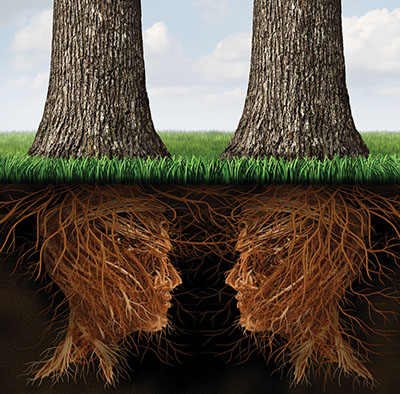
Fall/Winter 2017
How Trees Communicate and Network With Each Other
Just like the ever-expanding social networking that impact many of our lives, our trees are talking to their neighbors through an underground network of roots and fungi. Two decades ago, Canadian ecologist, Suzanne Simard, discovered that trees communicate their needs and send each other nutrients via a network of fungi buried in the soil. Since then, she has been pioneering further research into how trees communicate, including how fungi help trees send warning signals about environmental change, search for kin, and transfer their nutrients to neighboring plants before they die.
Simard’s current research is focused on understanding how these communication networks could be disrupted by environmental threats, such as climate change, pine beetle infestations, and logging. She believes these networks will go on -- whether they benefit native plants, exotics, or invader weeds.
Recently, her team also discovered what they termed “hub” or “mother” trees. These are the biggest, oldest trees in the network and the most connected to other trees. “Mother” trees recognize their kin and favor those seedlings with nutrients and defense enzymes over other trees in the forest. Simard believes that damage to these “hub” trees through logging, climate change or pest infestations can negatively affect the whole forest.
In a recent bestselling book called The Hidden Life of Trees, German forester Peter Wohllenen goes further with the idea of communication among trees. He claims that trees have friends, feel loneliness, scream with pain and communicate through the “wood wide web.” They are also very tribal and support their own species while harassing other species. He says trees such as beeches, oaks, Douglas firs and spruces all form forests that last for thousands of years because they take care of their own species while weakening trees from other species. Willows are like loners that grow fast but don’t live long. He likens city trees to street kids – isolated and struggling against the odds without strong roots.
Other researchers believe that even trees of different species communicate with and support each other through their mutual root zone. Warnings about insects, pathogens, and even herbivores are passed on to other trees in the neighborhood. They also share nutrients and carbon.
As arborists, it is important for us to consider and communicate these inter-connections and potential impacts like tree removals or changes in the environment that may disturb these networks.
Next time you take a walk in a park, look at the trees around you and imagine the chatter that is taking place underground.


LOCATIONS:
Lower Westchester County, NY and New York City
58 Beechwood Ave, New Rochelle, NY 10801
914-576-0193
Upper Westchester (North of I-287)
15 Broadway, Hawthorne, NY 10532
914-741-1510
Fairfield County, Connecticut
80 Lincoln Avenue, Stamford CT 06902
203-348-4111
Bergen & Passaic Counties, NJ
504 High Mountain Road, North Haledon, NJ 07508
973-636-6711
Contact us for a Free Consultation